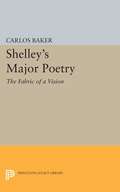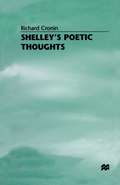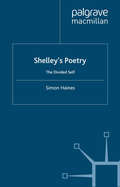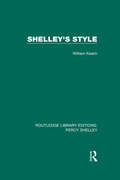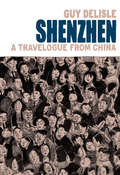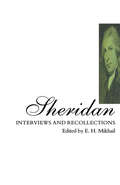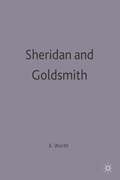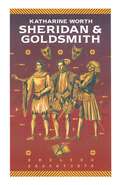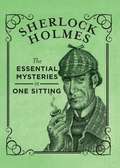- Table View
- List View
Shelley’s Living Artistry: Letters, Poems, Plays (Liverpool English Texts and Studies #69)
by Madeleine CallaghanThis study of the poetry and drama of Percy Bysshe Shelley reads the letters and their biographical contexts to shed light on the poetry, tracing the ambiguous and shifting relationship between the poet’s art and life. For Shelley, both life and art are transfigured by their relationship with one another where the ‘poet participates in the eternal, the infinite, and the one’ but is equally bound up with and formed by the society in which he lives and the past that he inherits. Callaghan shows that the distinctiveness of Shelley’s work comes to rest on its wrong-footing of any neat division of life and art. The dazzling intensity of Shelley’s poetry and drama lies in its refusal to separate the twain as Shelley explores and finally explodes the boundaries between what is personal and what is poetic. Arguing that the critic, like the artist, cannot ignore the conditions of the poet’s life, Callaghan reveals how Shelley’s artistry reconfigures and redraws the actual in his poetry. The book shows how Shelley’s poetic daring lies in troubling the distinction between poetry as aesthetic work hermetically sealed against life, and poetry as a record of the emotional life of the poet.
Shelley's Major Poetry
by Carlos BakerProfessor Baker is concerned primarily with Shelley's development ns a philosophical and psychological poet, and it is precisely in this that the great achievement of the book lies.Originally published in 1966.The Princeton Legacy Library uses the latest print-on-demand technology to again make available previously out-of-print books from the distinguished backlist of Princeton University Press. These editions preserve the original texts of these important books while presenting them in durable paperback and hardcover editions. The goal of the Princeton Legacy Library is to vastly increase access to the rich scholarly heritage found in the thousands of books published by Princeton University Press since its founding in 1905.
Shelley's Music: Fantasy, Authority and the Object Voice (RLE: Percy Shelley #4)
by Paul A. VatalaroFirst published in 2009. This book argues that the images of and allusions to music in Shelley’s writing demonstrate his attempt to infuse the traditionally masculine word with the traditionally feminine voice and music. This further extends to his even more fundamental desire to integrate the "object voice" with his own subjectivity. For Shelley, what plagues this integration is the prospect of losing both the poet’s authority and the subjectivity upon which it relies. This book asserts that the resultant deadlock and instability paradoxically becomes Shelley’s ultimate goal — creating a steady state of suspension that finally preserves both his authority and his humanity.
Shelley's Music: Fantasy, Authority and the Object Voice (RLE: Percy Shelley #4)
by Paul A. VatalaroFirst published in 2009. This book argues that the images of and allusions to music in Shelley’s writing demonstrate his attempt to infuse the traditionally masculine word with the traditionally feminine voice and music. This further extends to his even more fundamental desire to integrate the "object voice" with his own subjectivity. For Shelley, what plagues this integration is the prospect of losing both the poet’s authority and the subjectivity upon which it relies. This book asserts that the resultant deadlock and instability paradoxically becomes Shelley’s ultimate goal — creating a steady state of suspension that finally preserves both his authority and his humanity.
Shelley's Music: Fantasy, Authority, and the Object Voice
by Paul A. VatalaroShelley's Music: Fantasy, Authority and the Object Voice regards music images and allusions to music in Shelley's writing as evidence that Shelley sought to infuse the masculine word with the music of feminine expression. Set within his configuration of hetero-erotic relationships, this agenda reveals Shelley's desire to remain eternally present in his poetry. In the end, Shelley fails to achieve this goal, because he failed to overcome an even stronger desire to preserve male authority. Shelley's Music demonstrates that the main body of Shelley's writing consists of a fantasy aimed at unifying the word, traditionally associated with masculine power and authority, with voice and music, traditionally associated with the power and mystery of feminine expression. This particular fantasy extends an even more fundamental desire to integrate the "object voice" with one's own subjectivity. Structured along the lines of sexual difference and providing the coordinates for Shelley's construction of heterosexual and hetero-erotic correspondence, this phantasmic movement reveals Shelley's desire to make his voice eternally present in the written word. As Zizek reminds us, however, all fantasy inevitably exposes the very horror it means to conceal. For Shelley, what plagues the desire to merge word, voice and music is the prospect of losing both the poet's authority and the subjectivity upon which it relies. Recycling throughout his writing, Shelley's fantasy, then, generates deadlock and instability each time it finds renewed expression. Shelley's Music argues that this division paradoxically becomes Shelley's ultimate goal, because it maintains desire by creating a steady state of suspension that finally preserves for Shelley his authority and his humanity.
Shelley's Music: Fantasy, Authority, and the Object Voice (Rle: Percy Shelley Ser. #4)
by Paul A. VatalaroShelley's Music: Fantasy, Authority and the Object Voice regards music images and allusions to music in Shelley's writing as evidence that Shelley sought to infuse the masculine word with the music of feminine expression. Set within his configuration of hetero-erotic relationships, this agenda reveals Shelley's desire to remain eternally present in his poetry. In the end, Shelley fails to achieve this goal, because he failed to overcome an even stronger desire to preserve male authority. Shelley's Music demonstrates that the main body of Shelley's writing consists of a fantasy aimed at unifying the word, traditionally associated with masculine power and authority, with voice and music, traditionally associated with the power and mystery of feminine expression. This particular fantasy extends an even more fundamental desire to integrate the "object voice" with one's own subjectivity. Structured along the lines of sexual difference and providing the coordinates for Shelley's construction of heterosexual and hetero-erotic correspondence, this phantasmic movement reveals Shelley's desire to make his voice eternally present in the written word. As Zizek reminds us, however, all fantasy inevitably exposes the very horror it means to conceal. For Shelley, what plagues the desire to merge word, voice and music is the prospect of losing both the poet's authority and the subjectivity upon which it relies. Recycling throughout his writing, Shelley's fantasy, then, generates deadlock and instability each time it finds renewed expression. Shelley's Music argues that this division paradoxically becomes Shelley's ultimate goal, because it maintains desire by creating a steady state of suspension that finally preserves for Shelley his authority and his humanity.
Shelley's Poetry: The Divided Self
by S. HainesShelley's detractors since Hazlitt have noticed a division in the 'self' of his poems. A central reasoning core fears the passions surrounding it and distrusts the language expressing it. A few of his admirers offer an alternative view of the poems as symbolical pointers to a non-linguistic reality transcending passion; most miss the point, justifying their admiration by referring to the poems' systems of thought. This reading of Shelley's major poems and critical prose finds the adverse case more convincing.
Shelley's Process: Radical Transference and the Development of His Major Works
by Jerrold E. HogleIn this set of thorough and revisionary readings of Percy Bysshe Shelley's best-known writings in verse and prose, Hogle argues that the logic and style in all these works are governed by a movement in every thought, memory, image, or word-pattern whereby each is seen and sees itself in terms of a radically different form. For any specified entity or figure to be known for "what it is," it must be reconfigured by and in terms of another one at another level (which must then be dislocated itself). In so delineating Shelley's "process," Hogle reveals the revisionary procedure in the poet's various texts and demonstrates the powerful effects of "radical transference" in Shelley's visions of human possibility.
Shelley's Radical Stages: Performance and Cultural Memory in the Post-Napoleonic Era
by Dana Van KooyDana Van Kooy draws critical attention to Percy Bysshe Shelley as a dramatist and argues that his dramas represent a critical paradigm of romanticism in which history is 'staged'. Reading Shelley's dramas as a series of radical stages - historical reenactments and theatrical reproductions - Van Kooy highlights the cultural significance of the drama and the theatre in shaping and contesting constructions of both the sovereign nation and the global empire in the post-Napoleonic era. This book is about the power of performance to challenge and reformulate cultural memories that were locked in historical narratives and in Britain's theatrical repertoire. It examines each of Shelley's dramas as a specific radical stage that reformulates the familiar cultural performances of war, revolution, slavery and domestic tyranny. Shelley's plays invite audiences to step away from these horrors and to imagine their lives as something other than a tragedy or a melodrama where characters are entrapped in cycles of violence or struck blind or silent by fear. Although Shelley's dramas are few in number they engage a larger cultural project of aesthetic and political reform that constituted a groundswell of activism that took place during the Romantic period.
Shelley's Radical Stages: Performance and Cultural Memory in the Post-Napoleonic Era
by Dana Van KooyDana Van Kooy draws critical attention to Percy Bysshe Shelley as a dramatist and argues that his dramas represent a critical paradigm of romanticism in which history is 'staged'. Reading Shelley's dramas as a series of radical stages - historical reenactments and theatrical reproductions - Van Kooy highlights the cultural significance of the drama and the theatre in shaping and contesting constructions of both the sovereign nation and the global empire in the post-Napoleonic era. This book is about the power of performance to challenge and reformulate cultural memories that were locked in historical narratives and in Britain's theatrical repertoire. It examines each of Shelley's dramas as a specific radical stage that reformulates the familiar cultural performances of war, revolution, slavery and domestic tyranny. Shelley's plays invite audiences to step away from these horrors and to imagine their lives as something other than a tragedy or a melodrama where characters are entrapped in cycles of violence or struck blind or silent by fear. Although Shelley's dramas are few in number they engage a larger cultural project of aesthetic and political reform that constituted a groundswell of activism that took place during the Romantic period.
Shelley's Style (RLE: Percy Shelley)
by William KeachFirst published 1984. In a provocative study, this book argues that the problems posed by Shelley’s notoriously difficult style must be understood in relation to his ambivalence towards language itself as an artistic medium — the tension between the potential of language to mirror emotional experience and the recognition of it’s inevitable limitations. Through an exposition of Shelley’s idea of language, as reflected in his theoretical writings and individual poems, this book makes a strong case for his artistic worth. A definitive introduction to Shelley, useful for both scholars and newcomers, this book will be interest to students of literature.
Shelley's Style (RLE: Percy Shelley)
by William KeachFirst published 1984. In a provocative study, this book argues that the problems posed by Shelley’s notoriously difficult style must be understood in relation to his ambivalence towards language itself as an artistic medium — the tension between the potential of language to mirror emotional experience and the recognition of it’s inevitable limitations. Through an exposition of Shelley’s idea of language, as reflected in his theoretical writings and individual poems, this book makes a strong case for his artistic worth. A definitive introduction to Shelley, useful for both scholars and newcomers, this book will be interest to students of literature.
Shelley's Textual Seductions: Plotting Utopia in the Erotic and Political Works (RLE: Percy Shelley)
by Samuel Lyndon GladdenFirst published in 2002. This book surveys how and to what effect Shelley uses erotic narratives to mask political rhetoric within his attempts to describe and bring forth utopia. Posing erotic relationships as both an exemplar of the inequities of power and a paradigm for alternative social orders that dismantle oppressive structures, it argues Shelley’s work imagines a space where the rigidity of tyranny succumbs to the liberation of ecstatic union. From the Romantics to the Aesthetes, it argues that this model contributed to a counter-tradition in British literature which situates the erotic as a trope for political discourse. This work will be of interest to students of literature.
Shelley's Textual Seductions: Plotting Utopia in the Erotic and Political Works (RLE: Percy Shelley #1)
by Samuel Lyndon GladdenFirst published in 2002. This book surveys how and to what effect Shelley uses erotic narratives to mask political rhetoric within his attempts to describe and bring forth utopia. Posing erotic relationships as both an exemplar of the inequities of power and a paradigm for alternative social orders that dismantle oppressive structures, it argues Shelley’s work imagines a space where the rigidity of tyranny succumbs to the liberation of ecstatic union. From the Romantics to the Aesthetes, it argues that this model contributed to a counter-tradition in British literature which situates the erotic as a trope for political discourse. This work will be of interest to students of literature.
Shemlan: A History of the Middle East Centre for Arab Studies (St Antony's Series)
by James CraigShemlan, a small, once unknown village in the hills overlooking Beirut, became notorious throughout the Middle East when Bertram Thomas chose it as the location for the Middle East Centre for Arab Studies (MECAS) in 1947. The knowledge that a western government was taking pains to teach its citizens Arabic and inform them of Arab history, society and religion made the Arabs suspicious. The success of MECAS in producing specialists who were the envy of other governments produced doubt and anxiety. The power of MECAS to attract British but also foreign diplomats and businessmen should have made it a profitable enterprise; instead there was constant penny-pinching and reluctance to invest. In retrospect it looks like an excellent idea developed by improvisation through its early troubles which was then allowed to die in its prime. Was it yet another example of a British invention unexploited?
Shenzhen: A Travelogue From China
by Guy DelisleGuy Delisle's work for a French animation studio requires him to oversee production at various Asian studios on the grim frontiers of free trade. His employer puts him up for months at a time in 'cold and soulless' hotel rooms where he suffers the usual deprivations of a man very far from home. After Pyongyang, his book about the strange society that is North Korea, Delisle turned his attention to Shenzhen, the cold, urban city in Southern China that is sealed off with electric fences and armed guards from the rest of the country. The result is another brilliant graphic novel - funny, scary, utterly original and illuminating.
Sheridan and Goldsmith (English Dramatists)
by Katharine WorthEach generation needs to be introduced to the culture and great works of the past and to reinterpret them in its own ways. This series re-examines the important English dramatists of earlier centuries in the light of new information, ew interests and new attitudes. The books will be relevant to those interested in literatire, theatre and cultural history, and to threatre-goers and general readers who want an up-to-date view of these dramatists and their plays, with the emphasis on performance and relevant culture history.This book explores the reasons for the deep and lasting appeal of Sheridan's and Goldsmith's comedies, showing how they operate at the profound imaginative level and draw on their author's experience as Irish wits in an English scene. Their subtle dramatic techniques are examined in relation to physical features of the eighteenth-century stage. A chapter on sentimental comedy relates to plays such as Hugh Kelly's False Delicacy to the balance of irony and sentiment in Goldsmith's The Good Natur'd Man and Sheridan's A Trip to Scarborough. The continuing freshness of the comedy of mistakes, masks and Harlequin-like role playing which the two playwrights draw from the operatic and theatrical conventions of their day is illustrated from modern productions. These have helped to illuminate the psychological truth and social awareness underlying the sparkling surfaces of Sheridan's and Goldsmith's classic comedies.
Sheridan and Goldsmith (English Dramatists)
by Katharine WorthEach generation needs to be introduced to the culture and great works of the past and to reinterpret them in its own ways. This series re-examines the important English dramatists of earlier centuries in the light of new information, ew interests and new attitudes. The books will be relevant to those interested in literatire, theatre and cultural history, and to threatre-goers and general readers who want an up-to-date view of these dramatists and their plays, with the emphasis on performance and relevant culture history.This book explores the reasons for the deep and lasting appeal of Sheridan's and Goldsmith's comedies, showing how they operate at the profound imaginative level and draw on their author's experience as Irish wits in an English scene. Their subtle dramatic techniques are examined in relation to physical features of the eighteenth-century stage. A chapter on sentimental comedy relates to plays such as Hugh Kelly's False Delicacy to the balance of irony and sentiment in Goldsmith's The Good Natur'd Man and Sheridan's A Trip to Scarborough. The continuing freshness of the comedy of mistakes, masks and Harlequin-like role playing which the two playwrights draw from the operatic and theatrical conventions of their day is illustrated from modern productions. These have helped to illuminate the psychological truth and social awareness underlying the sparkling surfaces of Sheridan's and Goldsmith's classic comedies.
Sherko Bekas: A Kurdish Voice under the Lens of Critical Stylistics
by Ulrike Tabbert Mahmood K. IbrahimThis book explores poetry by Sherko Bekas, a Kurdish writer and Swedish Tucholsky award winner, providing contextualising biography (with original new information from an interview with his son) and critical stylistic analyses of two selected poems. The authors also include a section on the Kurdish language and translation of the poems into English. There are very few English translations of some of Bekas' poems and no book so far on the stylistic or even linguistic analysis of his work, with the result that Bekas is not widely known in the "Western" world. This book aims to fill this lacuna in the literary and linguistic canon, and it will be of interest to students and scholars of Translation, Stylistics, Middle Eastern History and Literature.
Sherlock Holmes (Pocket Essentials Ser.)
by Mark CampbellWho is Holmes? The world's most famous detective? A drug addict with a heart as cold as ice? A millstone around the neck of his creator? He's all of these things and much, much more. An iconic fictional creation, inseparable from his partner-in-crime Dr John Watson, Sherlock Holmes has charmed and fascinated millions of people around the world since his first appearance over a century ago. This book takes a look at the extensive collection of Sherlock stories penned by Sir Arthur Conan Doyle, as well as some of the sleuth's stage and screen incarnations.
Sherlock Holmes: The Essential Mysteries in One Sitting (RP Minis)
by Jennifer KasiusWith countless clubs, films, and books celebrating Sir Arthur Conan Doyle's legendary Sherlock Holmes, the popularity of literary history's favorite sleuth has never dimmed. Can you solve the case of the "Red-Headed League”? How about the "Empty House”? Sherlock Holmes can! All of the essential Holmes mysteries are efficiently organized in this tiny tome, which can either be enjoyed in small bites or devoured in one sitting. Featuring synopses, character profiles, and illustrations, this miniature edition brings to life the suspense and mystery of Sir Arthur Conan Doyle's classic tales.
Sherlock Holmes and Conan Doyle: Multi-Media Afterlives
by Sabine Vanacker and Catherine WynneSherlock Holmes is an iconic figure within cultural narratives. More recently, Conan Doyle has also appeared as a fictional figure in contemporary novels and films, confusing the boundaries between fiction and reality. This collection investigates how Holmes and Doyle have gripped the public imagination to become central figures of modernity.

